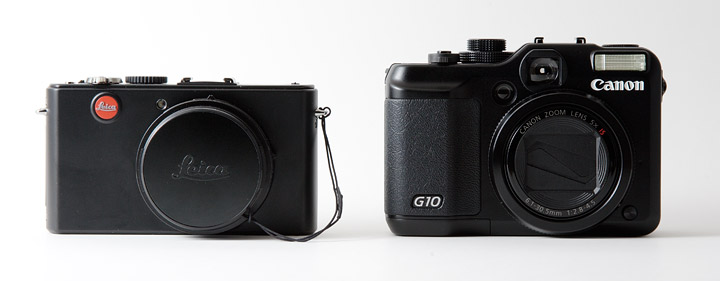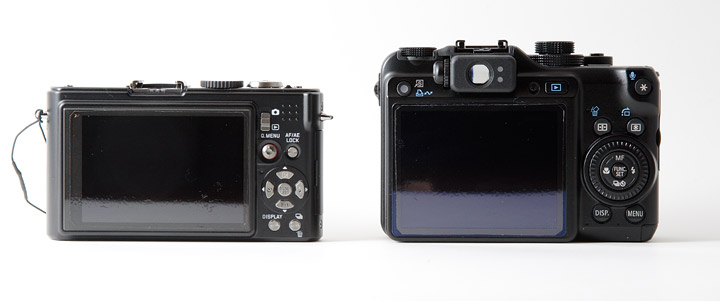As some may recall, I set out on a Canon G10 - Leica D-LUX 4 (Panasonic LX3) shootout a while back. In fact, I posted Part 1 of the shootout, but since work, family, and the GRD II review deterred me from continuing, I am starting again.
The Canon G10 and Panasonic LX3 are currently the #1 and #2 choices, respectively, amongst those shopping for an advanced digital compact with RAW capability. In conducting this shootout, my intention is not to comprehensively examine these cameras, but rather to cover some of the aspects which have not been covered elsewhere. The focus of the shootout will be on the RAW performance of the G10 and the D-LUX 4. I have no reason to believe that the D-LUX 4 and LX3 have any meaningful differences at the RAW level.
Before I begin, I'll disclose the fact that I no longer have the bias of ownership with either of these two cameras. I purchased them both for testing and thought about keeping each of them, but eventually I came to sell both.
In Part 1 of this shootout, we'll take a look at the design of these two cameras.
Here is the front view with the Leica on the left and the Canon on the right:

Both are attractive cameras in my opinion. The Canon is heavier and also taller, with room for the integrated optical viewfinder and flash.
The G10 has a nicer feel due to the contoured grip. The LX3, unlike the D-LUX 4, offers a bit of a grip, though not as substantial as that of the G10.
As you can see, the D-LUX has a traditional lens cap, while the Canon has a more convenient integrated lens cover. While I believe that most users will prefer the integrated lens cover, a removable lens cap such as the one on the D-LUX will provide greater protection. The leaflets protecting the G10 lens are displaced with the slightest pressure, and I do not trust them entirely when carrying the G10 in a pocket with other objects. This issue is offset by the fact that the G10 is not quite pocketable, at least not in the pants pockets to which I would carry an LX3/D-LUX 4.

Both the G10 and D-LUX have large, bright LCD displays. The D-LUX has a cheap-feeling, wobbly switch for changing between record and play modes. The rest of the rear buttons on the D-LUX are better than that switch, but overall the G10 buttons and dials have a firmer, higher quality feel.

The exposure compensation and ISO dials add to the G10 experience. Again, these two and the mode dial on the Canon have a good amount of resistance and click reassuringly at each setting, whereas the Leica mode dial feels a bit light. As you can see, there is a convenient aspect ratio switch on the D-LUX 4 lens. One very useful feature on the D-LUX/LX3 is that there is a dedicated focus button on the top panel for autofocusing transiently while in manual focus mode. The D-LUX also has a dedicated switch on the side for selecting the focus mode (manual, automatic, or automatic/macro).
The battery/storage card door on the G10 has a nice heft, while that of the D-LUX feels more flimsy. While both are solid cameras, the G10 gives the impression of better overall build quality.
In Part 2, I'll compare the field of view coverage of these two cameras as well as the barrel distortion at 28mm equivalent.
Canon G10 - Leica D-LUX 4 Shootout Pt. 1: Design and Build
Tuesday, December 23, 2008
Canon G10 - Leica D-LUX 4 Shootout Pt. 1: Design and Build
2008-12-23T22:23:00-05:00
Amin
Subscribe to:
Post Comments (Atom)
Recent Posts
-
▼
2008
(254)
-
▼
December
(10)
- Panasonic G1 - Nikon D700 ISO Shootout
- Panasonic G1 Size Comparisons
- Canon G10 - Leica D-LUX 4 Shootout Pt. 3: Dynamic ...
- Canon G10 - Leica D-LUX 4 Shootout Pt. 2: Field of...
- Canon G10 - Leica D-LUX 4 Shootout Pt. 1: Design a...
- Panasonic and Adobe - The Case Against DNG
- Raw Developer 1.8.2 Released
- GRD II Review, Supplement
- Ricoh GR Digital II Review
- DC Watch Comparison of GX200, P6000, G10, and LX3
-
▼
December
(10)

